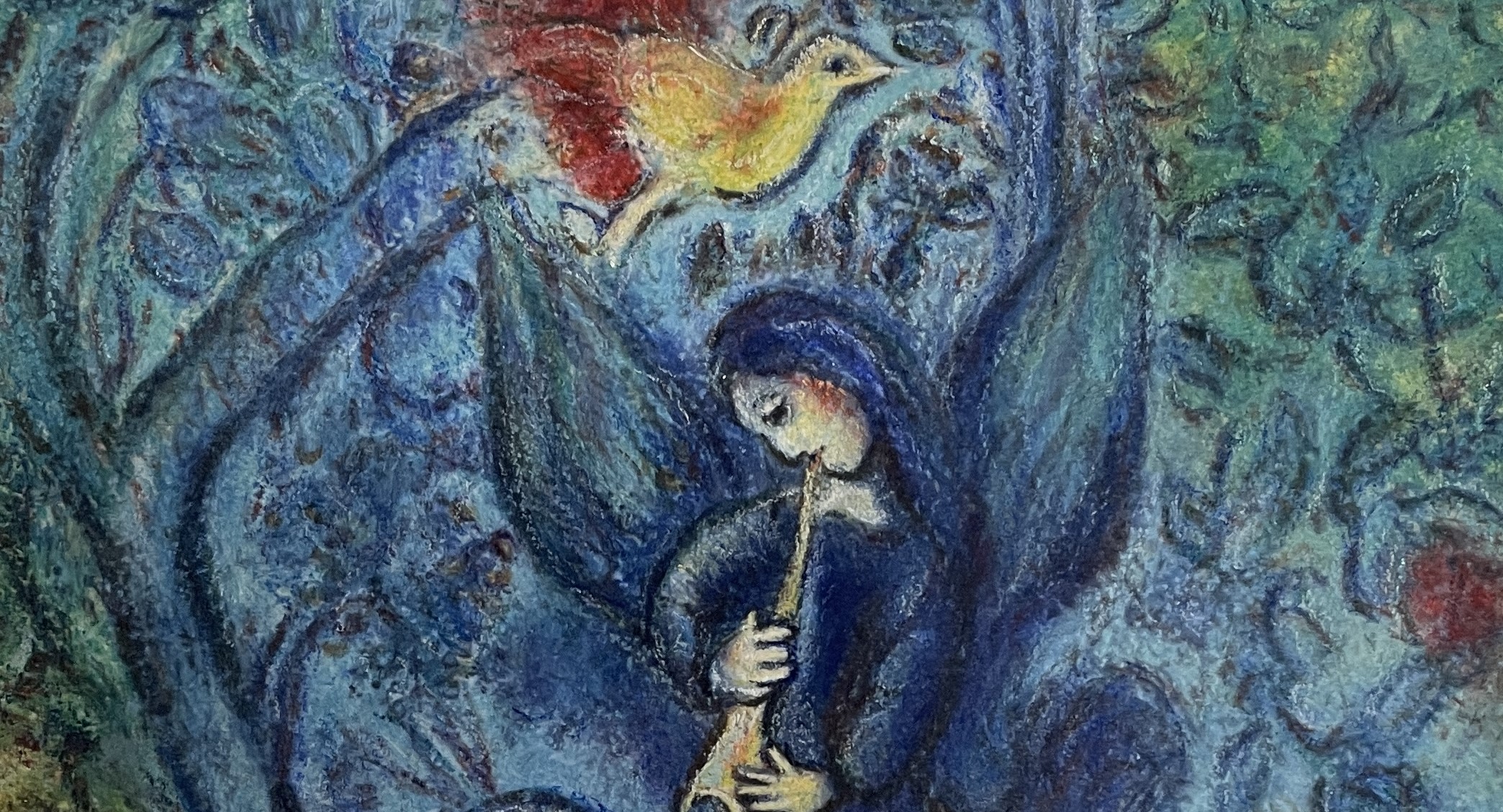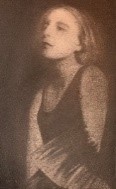日本語-Englishー台灣華語
タマラ・ド・レンピッカ「レンピッカの肖像」
タマラ・ド・レンピッカの絵画はレンピッカ自身の人生と瓜二つである。レンピッカは、ワルシャワの裕福な家庭に19世紀の末に生まれ、思春期をスイスとロシアで暮らす。15歳の時にオペラ観劇で見初めた美しい男性に恋をして、18歳でその男性と結婚する。ところが結婚して間もない1917年にロシア革命が起き、パリに亡命する。夫妻は持ってきた宝石を売りさばいて生活をしていたが、21歳の年に娘キゼットが生まれると、家計を立て直すため彼女は画家になる決心をする。天性の才能があったレンピッカはみるみる上達し、その美貌も手伝って一躍パリの肖像画家として有名になる。それまでパリで主流だった抽象画とは異なり、キュビズムの影響を受けつつも、鮮やかな色合で描かれたエレガントでファッショナブルな肖像画は、公爵夫人や名士たちに引っ張りだこになる。肖像画を描くにあたっては、気難しいモデルたちの気質を考慮して、まるで後のウォーホールのように1枚につき5万フランの一律料金で短期間に仕上げる商売人の一面を見せる。1920年代は新しく優美なスタイルである「アール・デコ」が生まれた時期である。レンピッカはアール・デコの申し子のような絶頂期を向かえるが、やがて熱狂的な流行が去ると、レンピッカもその輝きを失ってしまう。
この絵は、そんなレンピッカが絶頂を極めた1929年頃に撮影された「ロングドレスを着たタマラ」の写真を基に描いたものである。社交界の花形であったレンピッカは、グレタ・ガルボのように気取った姿でポーズを取っている。女優と見紛うばかりの美しさを備えたレンピッカは、まず自分自身を作品であるかのように際立たせた。スキャンダラスで自由な女性のイメージを定着させるかのように、私生活では男女を問わず関係を持ち、ボヘミアンな生活を謳歌する。この写真にはそんなレンピッカが集約されて現われている。私はレンピッカの作品よりは彼女自身を描くことにする。 アール・デコは1925年に開催されたパリ万国装飾美術博覧会で花開いたデザイン風潮である。世紀末のアール・ヌーヴォーが植物など曲線を多用した有機的なデザインであったのに対して、アール・デコは自動車や飛行機といった工業製品のように規格化された形態や近代的都市生活をテーマとした直線的なデザインが特徴である。この写真でレンピッカはまさにアール・デコを象徴する直線的なドレスに身を包んでいる。顔の陰影には細心の配慮がなさせ、レンピッカの絵画がどこか写真との親和性を持っていることをうかがわせる。レンピッカは当時流行の最先端ファッションを身につけた女性を数多く描いている。それまでの男性たちが描いた女性像とは異なり、堂々とした女性が官能的に描かれている。人物は画面一杯に配され、たった一色の緑や赤の服をまとった女性の肉体が量感を強調して描かれている。また作品にはストーリー性を持たせ話題を煽った。この写真が撮られた30歳の頃にレンピッカはクフナー男爵と出会う。はじめ男爵は愛人の肖像画をタマラに依頼したのだが、モデルとなった愛人に代わって、自分自身が男爵の愛人となり、その後クフナー男爵と結婚してしまう。文字道り男爵夫人という社会的地位を手に入れる。第二次世界大戦の脅威の中、夫妻はアメリカに居を移す。夫の男爵という立場を利用してハリウッドスターお気に入りの芸術家として名声を得るが、第二次世界大戦が終結する頃にはレンピッカ人気にも陰りが出始める。誇り高い彼女はアーティストとしての活動に終止符を打ってしまう。しかし時代は再び巡り、1970年代に入ると、レンピッカのファッショナブルでスタイリッシュな芸術はアメリカを中心に再評価される。ファッション界、芸能界などの著名人がこぞってコレクションをし始める。俳優のジャック・ニコルソンや歌手のマドンナはレンピッカの大ファンとして有名である。
レンピッカの絵画は時にポスターのように見えてしまうが、生き方を鮮やかに投影したその絵画には、不思議な生命力がみなぎっている。絵画には画家の力量や時代を超えて、画家の生き様をどれだけ込められるかが重要であることをレンピッカの作品は教えてくれる。
Portrait of Tamara de Lempicka
Tamara de Lempicka’s paintings are a mirror image of Lempicka’s own life. Born into a wealthy family in Warsaw at the end of the 19th century, she spent her adolescence in Switzerland and Russia. At 15, she fell in love with a beautiful man she saw at the opera, and at 18, she married him. However, shortly after their marriage, the Russian Revolution broke out in 1917, and they fled to Paris. The couple lived off the sale of their jewels, but when their daughter Kizette was born when Lempicka was 21, she decided to become a painter to support the family. Lempicka, who had a natural talent, quickly improved, and became famous as a portrait painter in Paris, aided by her beauty. Unlike the abstract art that was mainstream in Paris at the time, her elegant and fashionable portraits, influenced by Cubism yet rendered in vivid colors, became highly sought after by duchesses and celebrities. In her portrait work, she considered the temperaments of her difficult models, charging a flat fee of 50,000 francs per piece like Warhol would later do, finishing them in a short period, and showing a business-minded side. The 1920s was the period when the new and elegant style of Art Deco was born. Lempicka reached the pinnacle of her career as a perfect child of Art Deco, but as the enthusiastic trend faded, so did Lempicka’s brilliance.
The painting is based on a photo of “Tamara in a Long Dress” taken around 1929, when Lempicka was at her peak. As a socialite, Lempicka posed in a pretentious manner like Greta Garbo. With beauty that could be mistaken for that of an actress, Lempicka first made herself stand out as if she were a work of art. She lived a bohemian life, enjoying relationships with both men and women, and establishing the image of a scandalous and free woman. This photo encapsulates Lempicka in that essence. I decide to portray Lempicka herself rather than her works.
Art Deco is a design trend that blossomed at the Paris International Exposition of Decorative Arts held in 1925. Unlike Art Nouveau at the end of the century, which utilized organic designs with many curves, such as plants, Art Deco featured geometric forms and linear designs themed around modern urban life, resembling industrial products like automobiles and airplanes. In this photo, Lempicka is precisely wrapped in a straight-lined dress that symbolizes Art Deco. Careful attention to the shadows on her face suggests an affinity between Lempicka’s paintings and photography. Lempicka painted many women wearing the latest fashion trends of the time. Unlike the female images drawn by men before her, her paintings sensually depicted confident women. The subjects were arranged to fill the canvas, emphasizing the volume of women’s bodies dressed in a single color of green or red. The paintings also stirred conversation by incorporating narratives. Around the age of 30, when this photo was taken, Lempicka met Baron Kuffner. Initially, the baron commissioned a portrait of his mistress from Tamara, but instead, Tamara herself became the baron’s lover and later married him, acquiring the social status of a baroness. During the threat of World War II, the couple moved to America. Using her husband’s status as a baron, she gained fame as a favorite artist among Hollywood stars, but by the time World War II ended, Lempicka’s popularity began to wane. Proudly, she put an end to her artistic activities. However, as time turned again, by the 1970s, Lempicka’s fashionable and stylish art was reevaluated, primarily in America. Celebrities from the fashion and entertainment industries, including actor Jack Nicholson and singer Madonna, started collecting her works, known as big fans of Lempicka.
Lempicka’s paintings, at times resembling posters, are imbued with a mysterious vitality, vividly reflecting her way of life. Her works teach us that in painting, the artist’s skill, and the ability to infuse their life philosophy into their art are crucial, transcending time.
塔瑪拉·德·倫匹卡《倫匹卡的肖像》
塔瑪拉·德·倫匹卡的繪畫與倫匹卡本人的生活如出一轍。倫匹卡出生於19世紀末的華沙一個富裕家庭,青春期在瑞士和俄羅斯度過。她在15歲時在一次歌劇欣賞中對一位英俊的男士一見鍾情,並在18歲時與他結婚。然而,婚後不久的1917年俄國革命爆發,她們流亡至巴黎。夫妻倆靠著賣掉帶來的珠寶維生,當21歲的倫匹卡生下女兒基澤特時,她決定成為一名畫家以穩定家庭經濟。倫匹卡天賦異稟,畫技迅速提升,加上她的美貌,很快成為巴黎著名的肖像畫家。與當時巴黎主流的抽象畫不同,她的畫作受到立體主義的影響,描繪出典雅時尚的肖像畫,色彩鮮明,因而受到公爵夫人和名士的追捧。在繪製肖像畫時,她考慮到模特的性格,像後來的安迪·沃荷一樣,以五萬法郎的固定價格迅速完成畫作,展現了她做生意的一面。1920年代是「裝飾藝術」風格新穎、優雅的誕生時期。倫匹卡迎來了如裝飾藝術之子的巔峰時期,但隨著這股熱潮的消退,她也逐漸失去了光芒。
這幅畫是根據1929年左右拍攝的“穿著長禮服的塔瑪拉”照片繪製的。社交界的明星倫匹卡擺出了像葛麗泰·嘉寶那樣的矯揉造作的姿勢。擁有可與女演員媲美的美貌的倫匹卡首先使自己在作品中脫俗而出。像是為了固定下自由奔放的女性形象,她在私生活中不分男女建立關係,享受波希米亞式的生活。這張照片集中體現了倫匹卡的這些特質。我決定描繪的是倫匹卡本人,而不僅僅是她的作品。
裝飾藝術是在1925年舉行的巴黎國際裝飾藝術博覽會中盛開的設計風潮。與世紀末的新藝術運動使用植物等曲線進行有機設計不同,裝飾藝術以汽車、飛機等工業產品的標準化形式和現代都市生活為主題,特色是直線設計。這張照片中的倫匹卡正是包裹在代表裝飾藝術的直線式長裙中。臉部的陰影處理展現了細膩的關注,讓人感受到倫匹卡的繪畫與攝影之間存在的親和力。倫匹卡經常描繪當時流行的最前線時尚女性,與過去男性畫家描繪的女性形象不同,她的畫作中女性堂堂正正,充滿官能美。畫面中的人物充滿畫幅,單一顏色的綠色或紅色衣服強調了女性肉體的量感。作品還具有故事性,引發話題。倫匹卡在30歲時拍攝這張照片,當時她遇到了庫夫納男爵。起初,男爵委託她為情婦畫肖像,但最終倫匹卡自己成為了男爵的情婦,並與他結婚,獲得了男爵夫人的社會地位。在第二次世界大戰的威脅下,夫婦移居美國。利用男爵的地位,倫匹卡成為好萊塢明星們喜愛的藝術家,但到了第二次世界大戰結束時,倫匹卡的人氣也開始下滑。高傲的她最終結束了作為藝術家的生涯。然而,時代再次轉動,進入1970年代時,倫匹卡那時尚、風格化的藝術在美國重新獲得評價。時尚界、娛樂圈等名人開始爭相收藏。演員傑克·尼科爾森和歌手瑪丹娜是倫匹卡的著名粉絲。
倫匹卡的繪畫有時看起來像是海報,但那些生動投射了她生活方式的畫作中,蘊含著不可思議的生命力。這些畫作告訴我們,畫家的才能和跨越時代的能力,以及能在作品中投入多少畫家自己的生活,是非常重要的。


